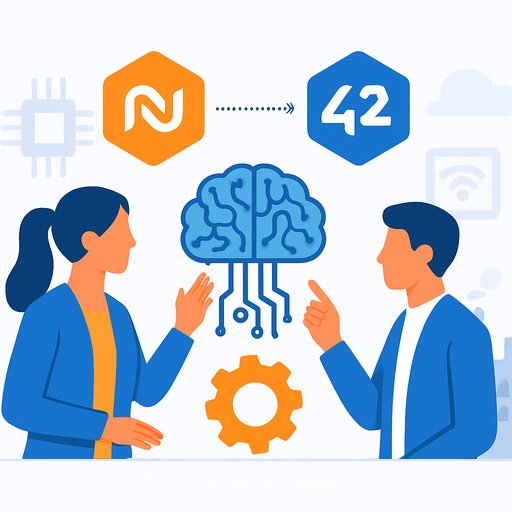Governing AI in Manufacturing & Design: Safeguarding IP & Ensuring Trust
AI can speed product development and sharpen decisions, but only if it works with clean, governed data. Your advantage comes from how well you classify, control, and route information to AI-without exposing sensitive IP.
The goal is simple: make AI a trusted partner that respects the same rules as your people, every time.
At a Glance
- AI needs more than a connected digital thread. It must distinguish data types and enforce access rules automatically.
- Prevent accidental IP exposure by controlling data at the source, not the interface.
Why data governance is the gatekeeper
"Garbage in, garbage out" still applies. If AI ingests stale or misclassified data, you get bad guidance and higher risk.
Product teams need trustworthy inputs, clear permissions, and consistent enforcement. That means governance is not a compliance checkbox-it's the foundation for useful AI.
Classify product data before you connect AI
A connected digital thread gives you traceability across CAD, PLM, MES, and field data. That's the base layer. AI needs one more thing: the ability to tell what it can use and what it must hide.
Start with three levels that any engineer can apply on day one:
- Unrestricted: Public specs, marketing materials, and standards. Safe for broad use.
- Sensitive: Data for active projects with limited audiences. Useful to approved teammates, but never a side door for anyone else.
- Confidential: Trade secrets, core designs, classified docs, and unique processes. Only available in tightly controlled cases with extra checks.
Example: If someone asks an assistant, "What's the secret formula?", the system should recognize the classification and block the response unless the user and purpose are approved. No exceptions.
Prevent accidental exposure
Protecting IP means AI follows the same access policies as your applications and your people. Put enforcement where the data lives and log every decision.
- Dynamic access control: Enforce permissions at the data-element level. A support agent's assistant should only draw from unrestricted content. A design engineer may access project-specific sensitive data, but still be blocked from confidential core IP.
- Targeted data streams: Don't give a single model full digital-thread access. Use filtered feeds per use case via purpose-built APIs. A partner portal assistant can request sensitive data after strong authentication, while an internal R&D assistant gets broader project access but remains blocked from confidential assets.
- Secure cloud integration: If you use cloud AI, connect it through a governance layer that delivers structured, accurate, permission-checked data. Keep secrets and confidential items isolated unless all controls pass.
Practical architecture for product teams
- Define a common data model and minimum metadata for each source system (CAD, PLM, QMS, MES, ERP).
- Apply classification at ingestion and re-check on access. Treat classification as versioned metadata, not a static label.
- Use a policy engine for role, purpose, and context checks (e.g., project, program, export control).
- Retrieve data through a gateway that filters by policy before any model sees it.
- Log prompts, retrieved items, decisions, and outputs for audit and incident response.
- Add human-in-the-loop approvals for confidential access and risky actions (e.g., generating supplier handoffs).
- Segment models and environments by sensitivity. Keep confidential workloads isolated.
- Run red-team prompts against your assistants to test leakage and prompt-injection resistance.
KPIs that prove it's working
- Percentage of data with correct classification and owners.
- Policy pass/fail rate per request and time-to-remediate misconfigurations.
- Incidents of unintended disclosure (target: zero) and mean time to detect.
- User adoption and task completion time in engineering, support, and supplier workflows.
- Model answer quality vs. source-of-truth alignment.
Common failure modes to avoid
- One assistant with blanket access to the entire digital thread.
- Copying sensitive PLM content into public chat tools "for convenience."
- Stale permissions that outlive a project or role change.
- Weak prompt-injection defenses that let external content override your rules.
- Over-redaction that makes the assistant useless to authorized engineers.
Getting started this quarter
- Weeks 1-2: Define classifications, owners, and a minimal policy set. Pick two high-value use cases (e.g., engineering search, supplier Q&A).
- Weeks 3-6: Implement the access gateway, connect 2-3 systems, and enforce policy checks. Pilot with a small group of engineers.
- Weeks 7-12: Add red-teaming, logging, and approvals for confidential access. Expand to a partner or support use case with filtered streams.
Helpful standards and guides
- NIST AI Risk Management Framework for risk controls and measurement.
- ISO/IEC 27001 for information security management and access practices.
Build capability across your product org
Governance works when product leaders, engineers, and data teams share the same playbook. Train teams on classification, policy basics, and how to work with AI assistants safely.
If you're formalizing skills across roles, see curated options here: AI courses by job.
The advantage goes to teams that manage, classify, and govern data with intent. Set the rules now, wire them into your digital thread, and AI will accelerate your roadmap without putting your IP at risk.
Your membership also unlocks:






